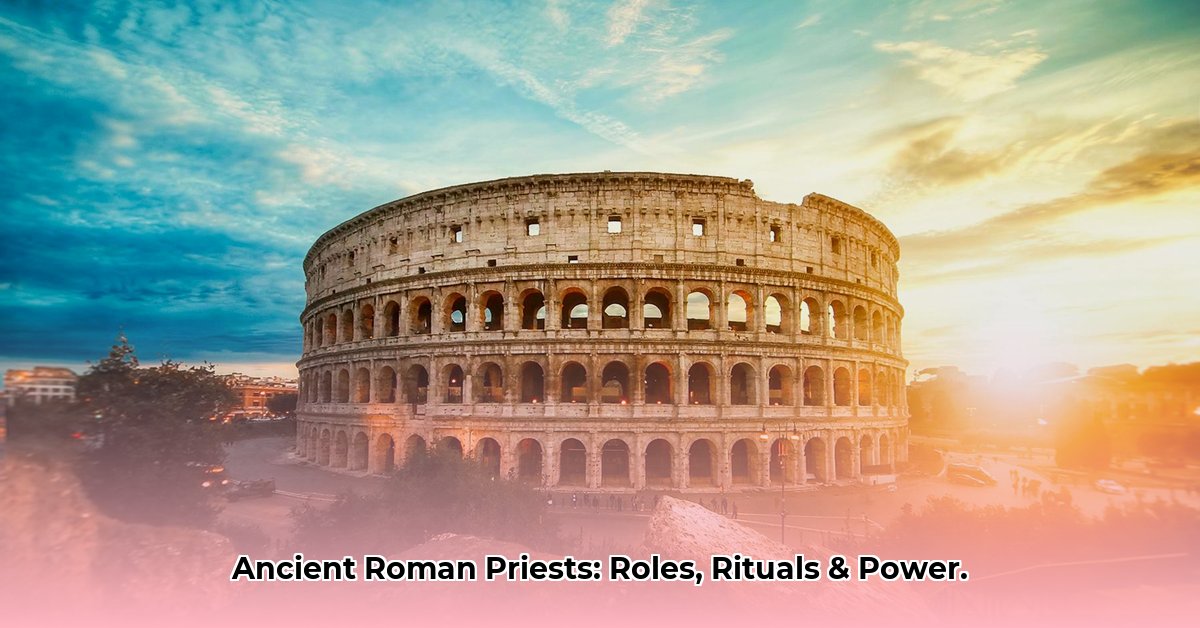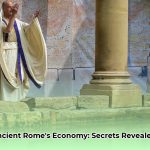Imagine a Rome not just of emperors and gladiators, but one vibrant with the hushed reverence of priests tending sacred fires and interpreting divine omens. This exploration delves beyond familiar narratives to reveal the surprisingly critical world of Roman priests. More than mere holy figures, they acted as the meticulous administrators who kept Rome’s entire religious machinery operating seamlessly. They were charged with interpreting divine will, managing elaborate rites, and even functioning as a sophisticated public relations team for the multifaceted Roman pantheon. From the supreme religious authority embodied by the Pontifex Maximus to the highly restricted Flamen Dialis, the priest of Jupiter, bound by an astonishing array of taboos, their responsibilities were incredibly diverse and profoundly impactful. This article will examine how these pivotal roles transformed over time, from the nascent days of the Republic to the expansive Roman Empire, how they skillfully incorporated new deities into the Roman religious framework, and why maintaining pax deorum—the peace of the gods—was considered absolutely vital for Rome’s enduring success and stability. You can learn more about related ancient Roman temples online.
The Foundations of Roman Priesthood
The ancient Roman priests were, in essence, the fundamental framework that united Roman society. Their function extended far beyond spiritual guidance; they were profoundly significant administrators tasked with maintaining the gods’ favor and, by extension, ensuring the stable operation and prosperity of Rome. This wasn’t simply about positive sentiments; it was about upholding pax deorum—the concept that Rome’s security and success depended critically on the state of its relationship with the gods. Their meticulously performed religious customs and the substantial influence they wielded were dynamic, consistently reflecting the shifting political and social landscape of Rome.
Understanding the responsibilities of Roman priests provides critical insights into the social structures of the time, and further exploration of ancient Roman society will reveal even more about daily life.
The priests’ duties extended into the physical realm, influencing the design and upkeep of sacred spaces, and to further appreciate their impact, one can unlock secrets of ancient Roman architecture, which often mirrored religious beliefs and practices.
The earliest origins of Roman priestly roles are deeply intertwined with the city’s foundational periods. Initially, priests were likely associated with specific families or clans, overseeing the veneration of ancestral gods and ensuring the welfare of their respective communities. As Rome expanded and absorbed cultural influences from neighboring civilizations, particularly the Etruscans, these nascent religious practices underwent a process of formalization, culminating in the establishment of priestly colleges and clearly defined roles.
While public cults received immense state attention, private worship also held significant importance. It was conducted within the home, in fields, and around the farm. Spirits, known as numina (divine powers or presences), watched over various parts of the household and farm. The pater familias, the head of the household, traditionally assumed the role of the family priest, leading rituals and prayers. The Lares, protective spirits of fields, safeguarded agricultural lands, and the Di Manes, spirits of the dead, were honored as departed ancestors. This duality of public and private religious life underscored the pervasive nature of Roman religious observance.
The Hierarchical Colleges: Specialized Teams for Divine Tasks
Roman religion did not rely solely on individual prominence; instead, it favored a collaborative, highly structured approach through its priestly colleges or boards. These were specialized units, each possessing distinct areas of expertise and specific responsibilities to ensure the continuous favor of the gods and the proper functioning of the state.
The Pontifex Maximus: Supreme Religious Authority
At the pinnacle of this hierarchy stood the Pontifex Maximus. This figure held the highest religious authority, exercising oversight over nearly every aspect of religious life—from minor daily rituals to defining the overarching direction of Roman religious practices. The role underwent a significant transformation; initially selected by his fellow pontifices, the position later became an elected office. By the time of the Empire, the emperor himself regularly assumed the title of Pontifex Maximus, consolidating both political and religious power, as exemplified by Julius Caesar and Augustus. This effectively linked the state’s highest political office with its supreme religious leadership, profoundly shaping the trajectory of Roman governance.
The College of Pontifices: Legal and Ritual Experts
Beneath the Pontifex Maximus, the Pontifices functioned as the legal experts of Roman religion. They provided counsel on all issues pertaining to religious law, ensuring strict adherence to protocols and offering interpretations of sacral law. They also played a crucial role in maintaining the Roman calendar, which dictated the dates of festivals and public business. Initially numbering three, and later five, their ranks expanded significantly over time, reaching 15 under Sulla and 16 under Caesar, accommodating both patricians and plebeians after the Lex Ogulnia in 300 BCE. They acted as mediators among other priests and meticulously maintained the Roman calendar, making them a combination of religious HR and legal counsel.
The College of Augurs: Interpreters of Divine Will
The Augures formed a priestly college separate from that of the pontifices, specializing in divination. Their primary task was to discover whether or not the gods approved of an action, mainly by interpreting divine signs in the movements of birds (auspicia). Such divination became an indispensable preliminary to state acts, though the ultimate responsibility for the decision rested not with the priests but with the presiding state officials, who were said to “possess the auspices.” The collection of omens might also manifest in thunder, lightning, or the observation of animal entrails. First established with three members, their numbers, like the pontifices, grew to 15 under Sulla and 16 under Julius Caesar. Their ability to question or invalidate auspicial legitimation made them highly political figures.
The Quindecimviri Sacris Faciundis: Custodians of Foreign Rites
These priests were the custodians of the Sibylline Books, prophetic texts consulted during times of crisis. The Quindecimviri Sacris Faciundis (Board of Fifteen, though earlier 10, then two) were tasked with deciphering their prophecies and devising solutions to challenges confronting Rome, particularly those related to foreign cults. They became crucial in managing the integration of new deities into the Roman pantheon, a key aspect of Rome’s flexible religious policy.
The Epulones: Overseers of Sacred Feasts
A new college of priests, the Epulones, was created in 196 BCE. Their primary job was to superintend the ceremonial banquets associated with Roman festivals, ensuring the proper performance of the Epulum Iovis (banquet of Jupiter) during the Ludi Romani and Ludi Plebei. Originally three (triumviri epulones), their number increased to seven under Sulla and ten under Caesar.
Lesser but Ancient Fraternities
Other significant, though sometimes less prominent, priestly groups included:
Fetiales: Priestly officials concerned with international relationships, such as treaties and declarations of war. They ensured the proper religious protocol for Rome’s foreign policy.
Salii: “Dancing priests” of Mars Gradivus (and later Quirinus), known for their distinctive apparel, carrying swords and spears, and performing ritual dances in March. There were two colleges of 12 Salii each.
Luperci: Priests who officiated at the ancient festival of Lupercalia on February 15, known for their ritualistic running through the city.
Arval Brothers (Fratres Arvales): A very ancient college of 12 priests whose job was to propitiate the gods who made the soil fertile, particularly the agrarian deity Dea Dia. Their well-documented activities illustrate the ongoing importance of older agricultural cults.
Sodales Titii: A college of priests whose function remains less clear, possibly related to Sabine rituals or a heroic cult.
Dedicated Priests and Unique Roles
Beyond the collegiate structure, several specific priesthoods held unique and vital positions within Roman religion, often with distinct origins and responsibilities.
The Flamines: Devotees of Individual Gods
The Flamines were priests attached to the cult of an individual god, also responsible for maintaining that deity’s temple. There were three major flamines, all patrician and believed to date back to King Numa:
The Flamen Dialis (Jupiter’s priest): Subject to an extraordinary series of taboos, some dating to the Bronze Age, making it difficult to fill the office in historic times.
The Flamen Martialis (Mars’s priest).
The Flamen Quirinalis (Quirinus’s priest).
Additionally, there were twelve flamines minores who served lesser deities, some of whom could be plebeian. Their tenure was typically for life.
The Flamen Dialis: Life Under Extraordinary Restrictions
The position of the Flamen Dialis was far from simple; he was bound by an astonishing array of restrictions, often sourced from ancient texts like Cicero’s “On The Public Priesthoods” and Aulus Gellius’s “Attic Nights.” These included prohibitions from riding a horse, viewing an army arrayed for battle outside the sacred boundary of Rome (pomerium), or taking an oath by Jupiter. He could not wear a ring unless it was perforated and empty, wear any knots in his attire, or even touch certain items like a female goat, raw meat, ivy, or beans. His hair could only be cut by a freeman, and his nail trimmings and hair had to be buried under a fruitful tree. His bed had to have a thin coating of clay on its feet, and he could not be away from it for three successive nights. These ancient taboos, some originating from Rome’s earliest history, highlight the intense dedication demanded and reflect deep-seated beliefs about purity, pollution, and the sacred separation of the priest from mundane or violent aspects of life. His wife, the Flaminica Dialis, also observed specific rules, demonstrating the comprehensive nature of these ritual obligations.
The Vestal Virgins: Guardians of Rome’s Sacred Flame
Among Rome’s most venerated religious figures were the six Vestal Virgins. Chosen as young girls (minimum age six) from old patrician families, they tended the eternal sacred fire of Vesta, the goddess of the hearth, in her distinctive circular shrine. Living in the House of Vestals nearby, they were bound by strict vows of chastity for a period of thirty years, a breach of which carried the severe punishment of being buried alive. Their role was crucial for the security of Rome, as the extinction of Vesta’s flame was believed to signify impending disaster. They enjoyed unparalleled status and privileges for women in Roman society, underscoring their profound importance.
The Rex Sacrorum: Vestige of Regal Religious Authority
After the expulsion of the kings, the Rex Sacrorum (king of the sacred rites) took over the residue of their religious powers and duties that had not been assumed by the Republican officers of state. To prevent him from assuming too much secular power, he was deliberately barred from holding public office or sitting in the Senate, making his duties almost exclusively professional and technical. As Livy noted, the duty of fastening the annual nail on the Ides of September, symbolizing the year’s count and originally performed by consuls or dictators, eventually passed to the Rex Sacrorum, highlighting his continued, albeit limited, ritual significance.
The Dynamic Evolution of Priestly Power
The roles of Roman priests were not static; they underwent significant evolution, reflecting the broader political and social currents within Rome. The interplay between religious and political authority was a constant, and often complex, dynamic.
Politicization and Republican Shifts
Initially, religious and political authority were largely inseparable, as seen in the Rex Sacrorum. However, with the emergence of the Roman Republic, priests increasingly exerted influence over key decisions. Priesthoods, particularly the major colleges, became attractive lifetime appointments for prominent men in public life. The social distinction and political leverage carried by these part-time posts caused them to be keenly fought for.
By the late Republic, the public priesthoods underwent a process of politicization, adapting these lifelong roles and the modes of accession to the model of annual magistracies. While popular election for most major colleges wasn’t implemented before 104 BCE (Lex Domitia), priests were consistently drawn from the leading families, forming powerful networks within the political elite. The augurs, for example, guided state actions through their interpretation of omens, creating a potent synthesis where religious observance seamlessly merged with political strategy. This strategic intertwining of religious power with political ambition profoundly shaped Republican governance.
Augustus’s Religious Revival and the Imperial Cult
The rise of emperors ushered in another profound transformation. Religious authority increasingly converged with political power, culminating in the deification of emperors and the prominence of the Imperial cult. Recognizing the importance of traditional religion for social order, Augustus, the first Roman emperor, initiated a significant religious revival. He revitalized ancient cults, restored temples, and actively promoted traditional Roman values. Crucially, he himself took the office of Pontifex Maximus in 12 BCE, making it a prerogative of the emperor until Christianity became the official religion, thereby emphasizing the direct link between political and state religion. This co-option of traditional priesthoods illustrated the adaptability, yet ultimate vulnerability, of the Roman religious system, as it became an instrument of imperial power.
Decline and the Rise of Christianity
The ascendancy of Christianity presented the most profound challenge to traditional Roman religion. With its monotheistic beliefs, active proselytizing, and unequivocal rejection of other gods and the Imperial cult, Christianity encountered far greater challenges than previous foreign religions, often leading to periods of intense persecution. Nevertheless, as history records, Emperor Constantine’s eventual endorsement marked a decisive shift toward Christianity in the fourth century, a transition later solidified by Emperor Theodosius, leading to the gradual decline and eventual suppression of the ancient pagan priesthoods and rituals.
Roman Syncretism: Integrating Foreign Deities
The stability of the Roman Empire significantly depended on its ability to manage a vast array of cultures, with religion serving as a paramount component. The Romans were not devout in the modern sense; their relationship with the divine was more transactional—pax deorum. They offered worship and sacrifices, expecting protection and prosperity in return.
Rome’s Pragmatic Religious Policy
What was the crucial element behind Rome’s religious success? It was a sophisticated blend of pragmatism, syncretism, and a carefully managed sense of inclusivity. Rather than imposing a rigid, uniform religious structure, they permitted a surprisingly high degree of flexibility. They combined personal rituals with official state ceremonies, thereby creating a system that catered to individual spiritual needs while simultaneously reinforcing political cohesion.
One of the most compelling aspects of Roman religious practice was their proactive willingness to adopt foreign gods. Their aim was not to supersede their existing deities, but rather to augment the established pantheon. Through a process known as interpretatio romana (Roman interpretation), they systematically identified foreign gods with their own, which significantly facilitated the integration of conquered peoples into the broader Roman world. This was a form of religious translation: upon encountering a new deity, they sought parallels with their own gods and, in essence, declared, “Ah, that is simply our Jupiter, but known by a different name!” This seemingly straightforward act fostered a sense of shared identity and effectively minimized the potential for religious conflict, promoting stability across a vast ethnically diverse empire.
Take the example of the Greek gods, readily absorbed into the Roman pantheon, with Jupiter assuming the mythology of Zeus and Venus incorporating the attributes of Aphrodite. Local cults were integrated, enriching Roman religious life without threatening traditional doctrine. This adaptive approach allowed them to leverage existing religious sentiments while maintaining overarching control. Temples were not merely spiritual centers; they evolved into vital hubs for daily life, functioning as banks, archives, and venues for public gatherings, thereby seamlessly integrating spiritual and practical functions.
Limits to Tolerance
However, Roman tolerance had distinct boundaries. They meticulously monitored religious activities for any perceived threats to public order. Cults that transformed into centers of resistance or engaged in practices deemed unacceptable faced stringent restrictions. Acceptable religions respected Roman authority, participated in public ceremonies, and maintained transparent operations.
The narrative of the Bacchanalian cult vividly illustrates this point. In 186 BCE, Roman authorities aggressively suppressed this Dionysian cult due to concerns about its secretive and potentially subversive activities that threatened social order. Judaism, with its monotheistic beliefs and refusal to venerate state gods, presented a unique challenge. Yet, for the most part, Rome accommodated Jewish practices to avert civil unrest, recognizing the importance of maintaining peace in this strategically vital region.
Christianity, however, with its active proselytizing and unequivocal rejection of other gods—including the emperor cult—encountered far greater challenges. This often led to periods of intense persecution, as Roman authorities viewed Christian non-conformity as a direct challenge to the very foundation of the Roman state, an affront to pax deorum. Nevertheless, as history records, Emperor Constantine’s eventual endorsement marked a decisive shift toward Christianity in the fourth century, a transition later solidified by Emperor Theodosius’s decrees making it the official state religion.
A Profound and Enduring Legacy
The priests of ancient Rome left behind a profound legacy that continues to shape our understanding of mythology, religious practices, and the intricate dynamics of power. Their roles were comprehensive and essential, evolving from simple ritual keepers to sophisticated administrators, legal experts, political influencers, and cultural assimilators.
From the hierarchical structure of the collegiate priesthoods to the highly specialized duties of individual priests like the Flamen Dialis and the Vestal Virgins, Rome’s religious system was a cornerstone of its society. These priests were not merely spiritual guides; they were instrumental in maintaining the pax deorum, ensuring state prosperity, advising on political decisions through omens, managing the influx of foreign deities, and safeguarding ancient traditions.
Their history underscores the profound intertwining of religion and governance, illuminating the complex roles individuals assume in shaping societal structures. Whether through meticulous ritual performance or astute political maneuvering, Roman priests were arguably more significant and multifaceted than typically acknowledged. Their enduring impact on one of history’s most influential civilizations provides invaluable insights into the complex interplay of belief, power, and societal stability, making their study essential for a comprehensive appreciation of the depth and breadth of Roman civilization.










